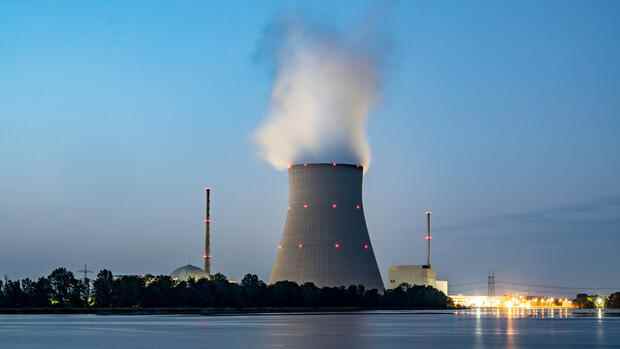The dispute over the continued operation of the nuclear power plants during the crisis has occupied the traffic light for a long time.
(Photo: dpa)
Berlin Olaf Scholz enforces the continued operation of the three nuclear power plants Isar 2, Neckwarwestheim 2 and Emsland until “April 15, 2023 at the latest”. The legal basis is created to enable the power operation of the three power plants. This is what it says in a letter from the Chancellor to Federal Minister of Economics Robert Habeck (Greens), Federal Minister of Finance Christian Lindner (FDP) and Minister of the Environment Steffi Lemke (Greens), who is responsible for nuclear safety. The Federal Press Office published the letter on Monday evening.
Scholz ended a week-long dispute between Habeck and Lindner. The liberals took the position that continued operation of all three nuclear power plants was therefore essential. When the Liberals speak of continued operation, they mean – unlike the Greens – up until now, however, continued operation until 2024.
Scholz, on the other hand, is now content with continued operation until mid-April 2023. In addition, the liberals would have preferred to have reactivated older plants in addition to the three nuclear power plants that are still in operation, which were shut down at the end of last year. Scholz also puts a stop to this solution.
The FDP felt confirmed by the second stress test that Federal Minister of Economics Robert Habeck (Greens) commissioned in the summer for the four operators of the electricity transmission networks – 50Hertz, Amprion, Tennet and TransnetBW. “Our message is very clear: It makes sense and is necessary to use all generation capacities,” said one of the company bosses at the beginning of September in the presence of Habeck. The liberals interpreted this as a request to continue operating all three reactors.
Top jobs of the day
Find the best jobs now and
be notified by email.
Habeck, however, drew a different conclusion from the stress test: He took the view that only two of the three nuclear power plants were still required: Isar 2 and Neckarwestheim 2 would be “transferred to a reserve,” said Habeck. They would be used “if the situation requires it,” said the minister just a few weeks ago. The kiln in Emsland, Lower Saxony, on the other hand, will finally go offline at the end of the year.
Green tip got approval at the party congress – but only for two miles
Even that was too much for many Greens. The rejection of nuclear power is in the party’s genes, it’s part of the founding myth. That is why the party leadership had to fight hard at the party congress to get approval for the reserve operation of the two southern German plants. In the end, she received the blessing of the party base. The Greens are convinced that April 15 next year should also be the end of the two piles. A significantly longer operation of nuclear power plants would be associated with the procurement of new fuel elements, which the Greens rejected at their party conference.
FDP boss Lindner, on the other hand, emphasized at the end of last week that he expected everyone involved not to draw red lines. “I can only say for myself: When it comes to averting damage to our country, reducing the ruinously high energy prices, preventing blackouts – then there are no red lines for me,” emphasized Lindner. “This isn’t about partisan politics.” He added, “I’ve jumped over my fiscal shadow billions of times.”
Now the FDP and the Greens have to make concessions. The Greens, because three instead of just two nuclear power plants remain on the grid. The FDP, because they have to shelve the continued operation until 2024.
More: Stress test for the energy transition – why the nuclear phase-out is not untouchable
